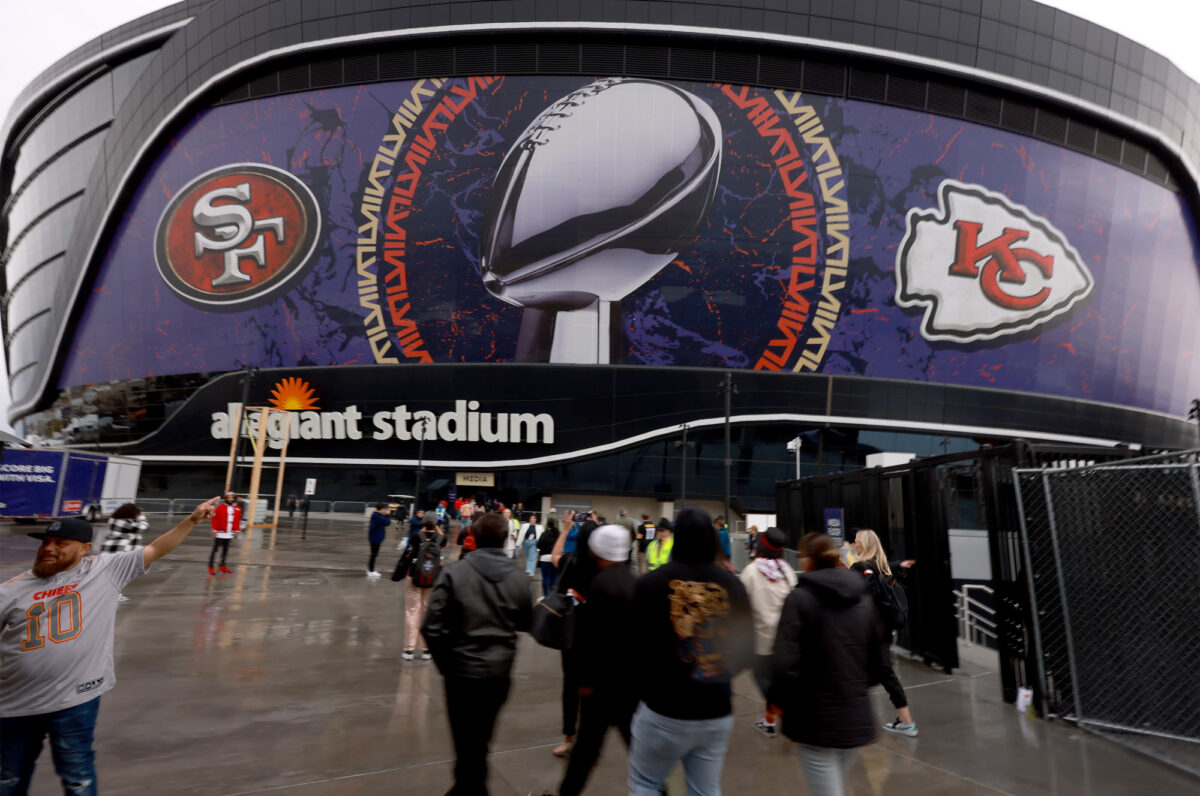Can F1 and the Las Vegas Motor Speedway co-exist in a suddenly crowded Las Vegas sports market?

Long before Formula One took over the heart of the Strip, NASCAR ruled Las Vegas.
F1’s 3.9-mile circuit for the Las Vegas Grand Prix, which includes a more than 1-mile stretch along the Strip, is temporary outside of the $500 million Grand Prix Plaza at the corner of Harmon Avenue and Koval Lane and will be gone by the holidays.
Miles away from the glitter of the Strip, the Las Vegas Motor Speedway and its 1.5-mile D-shaped oval track covers almost 1,200 acres and includes smaller racing venues. The facility, which is used year-round for special events, was built in 1996 by late casino owners Ralph Engelstad and Bill Bennett just north of Nellis Air Force Base. It hosted its first NASCAR race in 1998 and now hosts two annual NASCAR Cup Series races.
Las Vegas-based gaming consultant Brendan Bussmann said F1 and NASCAR serve different racing fans and visitor segments, but both can co-exist in the desert as part of the community’s ever-changing sports landscape.
“They can attract, in some cases, the same customer who just loves racing,” Bussmann said.
Had Engelstand and Bennett “not taken a bet on NASCAR,” Bussmann said it would be unlikely for Las Vegas to host its third F1 race this weekend, with others lined up over the next decade.
“The NASCAR customer that we saw just a few weeks ago is completely different than what will be coming in for F1,” Bussmann said. “But that is the beauty of Las Vegas. We can host it all.”
In addition to NASCAR races and other racing programs, the motor speedway draws other events large and small — from corporate gatherings to the three-day Electric Daisy Carnival, better known as EDC, and that attracts more than 100,000 attendees.
New speedway General Manager Patrick Lindsey was hired in March following the retirement of Chris Powell, who spent 26 years in the role.
He said that for the location to succeed in the new sports ecosystem in Las Vegas, it has to be more than just a racing venue.
“We don’t like to kind of pigeonhole ourselves into just being a motor sports complex,” said Lindsey, who previously spent two decades in sports management, including nine years as executive director of Las Vegas’ PGA Tour event, the Shriners Children’s Open.
“We are an entertainment complex, and we are actually the largest entertainment complex in the city,” he said.
The motor speedway is the third-oldest sports venue in Las Vegas, built after the 18,000-seat Thomas and Mack Center at UNLV in 1983 and the 19,000-seat MGM Grand Garden in 1993.
Since then, eight other sports and entertainment venues of various sizes have arrived on the Las Vegas scene — from the 4,600-seat equestrian center at the South Point Hotel and Casino to the 60,000-seat Allegiant Stadium. A ninth venue, a 33,000-fan capacity Major League Baseball stadium on the Strip, is expected to open in April 2028.
Is it overkill?
Las Vegas Convention and Visitors Authority CEO Steve Hill says no — the speedway hosts hundreds of events and is a draw for conferences and corporate meetings, beyond NASCAR and EDC.
During large trade shows and conventions such as the Consumer Electronics Show, exhibitors and companies host customers and employees for activities such as taking “hot laps” around the track with a professional driver at the wheel.
“A lot of groups coming to Las Vegas for meetings look for something fun to do, especially during trade shows and conferences,” Hill said. “Given the breadth of venues and the different locations, they are a real benefit and complementary to everything we’re doing in Las Vegas. They’re part of the draw.”

Racing on the edge of town
Engelstad and Bennett — both racing fans — got together and spent $72 million to transform a dusty racetrack just north of Nellis Air Force Base along Interstate 15 into a suitable motorsports venue.
In 1998, the facility’s first NASCAR race drew 120,000 spectators and the attention of North Carolina-based Speedway Motorsports Group, which paid Engelstad and Bennett $215 million to acquire the facility.
A 2006 renovation reduced capacity but upgraded the facility with improved parking and brought new fan-friendly attractions unique to NASCAR in Las Vegas, including the interactive Neon Garage added to the infield behind pit row that provides spectators with an up-close view of the race cars and racing teams.
The speedway annually hosts two nationally televised NASCAR races: the South Point 400, which Florida-native Denny Hamlin won last month, and the Pennzoil 400 in March. Each draws more than 60,000 fans to the grandstands and luxury suites, as well as several thousand stock car racing enthusiasts who camp out in the infield.
Lindsey said the National Hot Rod Association attracted 15,000 fans while the Bullring, a 3/8-mile paved oval track with seating for 5,400, offers various racing varieties, including stock car events for locals. The speedway has also hosted everything from monster truck events and motocross to drifting races, where drivers intentionally skid their cars sideways through a course.
“After three decades, we are still kind of on the edge of town. But the state has done an incredible job with our roadways, so we’re pretty easy to get to,” Lindsey said. “Even our neighbors from the north. It’s very easy for Utah to come down here.”
Motor speedway leadership did not have an economic impact statement for the 2024 races, though the Las Vegas Convention and Visitors Authority said the 2022 fall NASCAR race brought in an estimated $138 million to the community.
The newer F1 race has made a bigger splash. The Las Vegas Grand Prix arrives Thursday for three days of events, culminating with Saturday night’s race with 50 laps, or nearly 193 miles, around the circuit. Last year’s event drew 175,000 visitors to Las Vegas, many of whom attended high-priced events around the Strip, and generated $934 million in Southern Nevada economic activity, according to financial consulting firm Applied Analysis.
F1 owner Liberty Media developed the 300,000-square-foot Grand Prix Plaza to establish Las Vegas as the home of F1 in America. It opened to the general public between May and September with a variety of race-themed interactive offerings, including a go-kart racing circuit along a portion of pit row and through the garages.
“We wanted to introduce the facility to all the major chambers [of commerce] and the various groups that come into town,” said Lori Nelson Kraft, Las Vegas Grand Prix senior vice president of corporate affairs.

F1 and Speedway build relationships with resorts
With a few exceptions, F1 and NASCAR have largely attracted different segments of racing fans.
Ellis Island Hotel & Casino, located just north of the Grand Prix’s fourth turn onto the Koval Lane straightaway, offered grandstand seating during the 2023 inaugural race. The property took 2024 off as it underwent a renovation and expansion.
This week, the off-Strip casino is selling tickets to a Grand Prix viewing party inside the property’s Front Yard restaurant that includes free access to a new rooftop viewing platform.
Las Vegas neighborhood casinos have shown the telecast of the F1 race alongside college football games in their sportsbooks.
However, the Strip’s high-end resort companies are by far the biggest F1 race beneficiaries.
“You can look at our published room rates for the event and see that we are once again pricing at a significant premium to the market,” Wynn Resorts CEO Craig Billings said on the company’s third-quarter earnings call on Nov. 6. Wynn Las Vegas and Encore President Brian Gullbrants said a three-night minimum during the race weekend is required and the company bought three additional ticket blocks for customers.
“I think [the race] continues to pay dividends for not just us, but for the market,” Gullbrants said.
For the third year, MGM Resorts constructed the multilevel Bellagio Fountain Club along the Strip and in front of the resort’s fountains. Guests pay nearly $9,400 to watch the race while dining on meals prepared by Michelin-starred chefs. An upper-deck nightclub-like setting offers additional views of the Strip.
Other casino companies view F1 and NASCAR differently.
Boyd Gaming CEO Keith Smith said a year ago that F1 didn’t provide any financial benefit to its properties. During an interview following the company’s quarterly earnings in October, he said that NASCAR is a better fit for the company’s customer base. Boyd’s Aliante Casino in North Las Vegas is 10 miles from the motor speedway.
“[F1 and NASCAR] are two completely different types of events. I think NASCAR appeals more to Middle America, which I think is far more our variety of customers,” Smith said.
South Point General Manager Ryan Growney said the resort's relationship with the motor speedway extends beyond the multiyear race sponsorship agreement. Property owner Michael Gaughan’s son Brendan is a former NASCAR driver.
South Point signage is found around the oval and in other areas of the track. South Point also purchases NASCAR packages for customers and provides round-trip transportation to and from the speedway.
“Our property is committed to professional sports and the events that come to town. It just made sense for us to partner with the speedway,” Growney said.

Sports venues grow in Las Vegas
Before the speedway opened, Las Vegas had just two venues: Thomas & Mack and MGM Grand Garden. Both are still in use — Thomas & Mack is home to the UNLV Runnin’ Rebels basketball team, and the MGM Grand Garden has hosted scores of sporting and other events.
After the motor speedway arrived, competition for Las Vegas sports and entertainment venues heated up. Mandalay Bay’s 12,000-seat Michelob Ultra Arena opened in 1999, along with the Strip resort. The 9,500-seat Orleans Arena opened at the off-Strip Orleans Hotel & Casino in 2003.
South Point added a 4,600-seat equestrian center in 2005, while the 20,000-seat T-Mobile Arena opened in 2016. Howard Hughes Corp. built the 10,000-seat Las Vegas Ballpark in 2019. Foley Entertainment Group built the 5,600-seat Lee’s Family Forum in 2022.
The $1.9 billion Allegiant Stadium opened in 2020 during the pandemic and hosted its first Las Vegas Raiders games with fans in attendance in 2021. The venue, partially supported by public financing in the form of a hotel room tax, was also the host of Super Bowl LVIII in 2024 and is lined up to host the championship game in 2029.
Along with the Grand Garden, two of the venues operated by MGM Resorts International have full-time tenants — the WNBA’s Las Vegas Aces at Michelob Ultra and the NHL’s Vegas Golden Knights at T-Mobile Arena.
MGM Executive Vice President of Entertainment Chris Baldizan said significant differences in the three arenas’ capacities appeal to promoters. “We’re able to host artists and events of all ranges.”
Athletics President Marc Badian, who oversaw the development of Allegiant and is now in charge of building the baseball team’s $2 billion stadium on the former Tropicana site, said concerns that newer venues would take away business from other locations in Las Vegas have been unfounded.
“The opposite has happened. Concert promoters have brought more events to Las Vegas,” Badain said. “This market had a lot more demand than the existing infrastructure could support. Instead of bypassing Las Vegas, it was much more economical for promoters to add shows here.”
